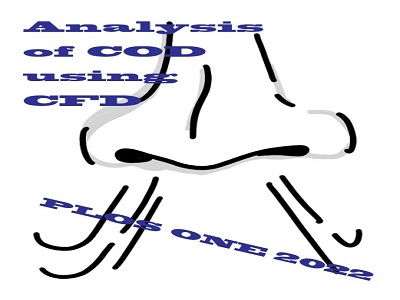【Fig3’s supp.】Analysis of COD using CFD
2022/01/23

Analysis of conductive olfactory dysfunction using computational fluid dynamics
PMID: 35020767
DOI: 10.1371/journal.pone.0262579
The main points of this paper are summarized in Fig. 3.

Human olfactory dynamics are classified into three types, the left column, the center column, and the right column, respectively.
The left column is for people with normal sense of smell, the middle column is for patients with COD and nasal breathing alone, and the left column is for patients with COD and mouth combined breathing.
The upper row is a simulation calculated by taking data from an actual human and assuming only nasal breathing. Red shows the right olfactory cleft and purple shows the left olfactory cleft.
The upper, olfactory clefts (A) and (C) have a general slit-shaped shape, but the olfactory cleft of (B) is open only anteriorly and can be said to be an abnormal shape.
The middle, (D),(E),(F) also shows the nasal resistance calculated assuming only nasal breathing, and 62.08 Pa of (F) is an abnormally large value, which is “a virtual value on the simulation that is not actually realized”.
In that case, the fact that high nasal resistance value is unrealistic leads to the conclusion that those humans must use supplementary mouth breathing as shown in schematic diagram (I), because we cannot live without breathing.
What should not be misunderstood here is that “a person who breathes through the mouth does not necessarily have an olfactory disorder.”
In other words, the interpretation in the right column is that “a patient of COD with combined mouth breathing is one who has a relatively large obstacle in the flow path up to that point even if the shape of the olfactory cleft is normal.”
In other words, the interpretation in the right column is that “a patient of COD with combined mouth breathing is one who has a relatively large obstacle objects in the flow path way to olfactory receptors even if the shape of the olfactory cleft is normal.”
The interpretation of the middle column is that “a patient with COD with nasal breathing alone have some abnormality in the shape of the olfactory cleft.”
